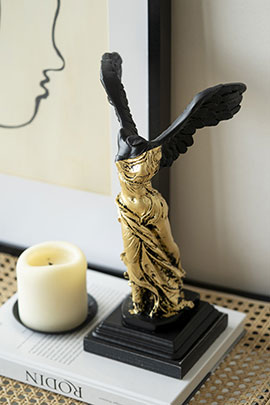Description
Pegasus was the winged horse of Greek Mythology, about which, although Homer does not mention him, there are the following traditions:
1. When Perseus beheaded Medusa, who had made Poseidon pregnant, Chrysaoras, Gyrionis’ father, and Pegasus, the winged horse, jumped out of the incision. According to one testimony, Pegasus was born from the blood that fell into the sea. Then Perseus, riding him, managed to escape the pursuit of the other two mermaids, Medusa’s brothers or, in the most common form of the legend, with his winged sandals. Pegasus was therefore the son of Poseidon and Medusa.
2. According to Hesiod, his name is due to the “Sources” of the Ocean where he was born, so the name is said to be related to sources. Pegasus, winged as he was, ascended to Olympus, the seat of the Immortals, and resided in the service of Zeus, used to transport lightning from Hephaestus’ laboratory to Olympus. (Theogony 281-286, Apollodorus II 3, 4).
3. According to the mythological tradition that prevailed in Corinth, Pegasus was a Corinthian deity par excellence, for whom coins were minted with his image. It was said that as soon as Pegasus sprang from Medusa, it flew to Acrocorinth and quenched its thirst in the waters of the Pyrenees, hence the name “Pyrenean pole” from then on. Then the traditions of the Corinthians associate Pegasus with the tradition of Bellerophon and Chimera.
4. The association of Pegasus with the Muses is due to the following tradition: When the Muses once competed in the song with the daughters of Pieros, on the river Elikonas, as soon as the Pierians daughters started singing, everything was dark. Immediately after, when it was the turn of the Muses, everything seemed to stop, Uranus, the Sea, the rivers, to hear the exquisite hymns, and Elikonas began to ascend to the sky with joy and pride until he was stopped by the winged Pegasus, by order of Poseidon, kicking him with his hooves. From this kick was born the spring of Elikonas, whose waters inspired the Muses, the so-called Hippocrates.
 Certificate of authenticity
Certificate of authenticity Premium package
Premium package Greek product
Greek product Shipping
Shipping Hand paint
Hand paint Non luxurious packing
Non luxurious packing Ceramic
Ceramic Alabaster
Alabaster Candle
Candle White stone
White stone GLASS
GLASS







 Free Shipping
Free Shipping
Excellent decoration in modern color combinations. Made of alabaster and hand-painted with vivid colors, for durability and durability respectively, on a skated wooden base with a special felt lining at the bottom for comfortable soft support on any piece of furniture in your home or office. Choose it as an ideal luxury gift or add it to your collection. Get inspired, create and decorate the space you want by choosing the unique ArtCulture products